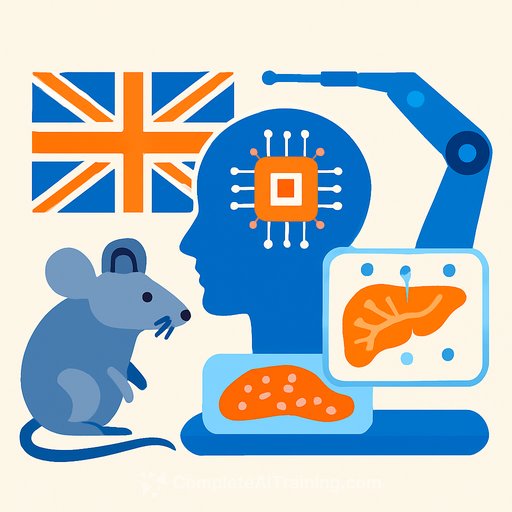UK plan sets faster path to replace animal testing with AI and human-relevant models
The UK has set a clear direction: phase out animal testing faster by scaling AI, organ-on-a-chip systems, and 3D bioprinted tissues. Science minister Patrick Vallance outlined a strategy that ties new funding to validated alternatives and streamlined regulation.
The plan doesn't remove animal work overnight. It replaces it where methods can match safety and performance for human exposure. That means pragmatic transitions, not wishful thinking.
What's in the roadmap
- Targeted funding and simpler regulation to speed non-animal methods into use.
- AI models to predict safety and efficacy from molecular and preclinical data.
- Organ-on-a-chip platforms using human cells to mimic organ function.
- 3D bioprinted tissues (skin, liver, and more) to run fit-for-purpose assays.
Vallance framed it plainly: the country wants to end suffering where possible and roll out alternatives as soon as they're proven safe and effective. The RSPCA called the strategy a solid foundation for ethical, high-quality science-if it's implemented well.
Timelines and targets
- By end of 2026: end regulatory animal tests for skin/eye irritation and skin sensitisation.
- By 2027: end mouse potency assays for botulinum toxin (botox) strength testing.
- By 2030: reduce pharmacokinetic studies on dogs and non-human primates.
These dates will pressure programs to shift assay portfolios, data pipelines, and validation plans now-not in 2029.
What researchers should do now
- Map current animal-dependent assays against the 2026-2030 milestones and flag high-risk dependencies.
- Stand up an alternatives workstream: organ-on-a-chip pilots, bioprinted tissue assays, and AI toxicology models.
- Co-develop validation protocols with QA and biostatistics; pre-align with regulators to de-risk submissions.
- Build GLP-compliant data capture for in vitro and in silico studies; plan for audit trails and model versioning.
- Upskill teams in computational methods (QSAR, PBPK, uncertainty estimation) and assay transfer/bridging.
Methods stack: AI, organ-on-a-chip, and 3D bioprinting
AI: Use multi-modal models that blend structure-based features, bioactivity profiles, and early in vitro readouts. Prioritize external validation, applicability domain checks, and uncertainty quantification. Maintain model cards and data lineage for review.
Organ-on-a-chip: Select platforms with demonstrated reproducibility, physiologic relevance, and throughput that matches study needs. Validate against historical human/clinical benchmarks where possible.
3D bioprinted tissues: Start with skin and liver where test guidelines and reference datasets are stronger. Lock down lot-to-lot consistency, histology, and function markers before regulatory use.
Regulatory implications
Regulators will accept alternatives that show equal or better protection for human health and the environment. Expect demand for transparent protocols, cross-lab reproducibility, and clear statistical equivalence to legacy methods.
- Use established non-animal OECD Test Guidelines where available.
- Plan bridging studies that connect new assays to prior decisions and clinical outcomes.
- Adopt FAIR data practices and GLP where required; ensure model interpretability for safety decisions.
Helpful starting points: the NC3Rs guidance and the OECD Test Guidelines for validated non-animal methods.
Funding and infrastructure
The strategy ties new grants to method development and uptake. That likely means more calls for chip-based ADME/Tox, AI-first safety modeling, and human tissue platforms-and faster review cycles.
To compete, assemble cross-functional teams (biology, toxicology, data science, QA), line up clinical comparators, and document a clear path to regulatory acceptance.
Risks and how to manage them
- Model overfitting and bias: use external test sets, prospective validation, and strict version control.
- Assay variability: run inter-lab ring trials early; quantify precision and lot effects.
- Generalizability: define applicability domains; pair AI with mechanistic models (e.g., PBPK) where feasible.
- Operational change: update SOPs, LIMS/ELN integrations, and staff training before submission deadlines.
Bottom line for science and research teams
The direction is clear and the clock is ticking. Shift resources to human-relevant methods, prove equivalence with strong validation, and get your data and models ready for scrutiny.
If you need to upskill staff on practical AI for R&D, see curated options by role at Complete AI Training.
Your membership also unlocks:






